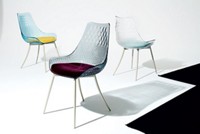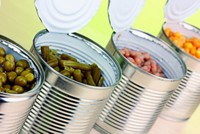Advertisement
Grab your lab coat. Let's get started
Welcome!
Welcome!
Create an account below to get 6 C&EN articles per month, receive newsletters and more - all free.
It seems this is your first time logging in online. Please enter the following information to continue.
As an ACS member you automatically get access to this site. All we need is few more details to create your reading experience.
Not you? Sign in with a different account.
Not you? Sign in with a different account.
ERROR 1
ERROR 1
ERROR 2
ERROR 2
ERROR 2
ERROR 2
ERROR 2
Password and Confirm password must match.
If you have an ACS member number, please enter it here so we can link this account to your membership. (optional)
ERROR 2
ACS values your privacy. By submitting your information, you are gaining access to C&EN and subscribing to our weekly newsletter. We use the information you provide to make your reading experience better, and we will never sell your data to third party members.
Materials
Trading Places With Bisphenol A
BPA-based polymers' useful properties make them tough materials to replace
by Mitch Jacoby
December 15, 2008
| A version of this story appeared in
Volume 86, Issue 50

A STEADY FLOW of reports, claims, and counterclaims in recent months regarding the health hazards of bisphenol A (BPA) have thrust that chemical reagent into the media spotlight. Used around the globe, BPA serves as a chemical building block from which polycarbonate plastics and epoxy resins are made. Because of their useful chemical and physical properties, those materials make their way into products including sports, medical, and electronic equipment, but lately, their use in water and food containers has increasingly come under fire.
Those concerns have sent some manufacturers looking for BPA-free subsitutes, but finding suitable replacements is no easy task.
For more than 50 years, products made from BPA-based materials have been available in the marketplace. Owing to their toughness, heat resistance, and optical properties, polycarbonates are widely used to manufacture CDs and DVDs, automobile parts, and sports safety equipment. Many of those key properties have also made polycarbonate plastics a choice material for making reusable water and baby bottles, food-storage containers, and tableware. Similar in some ways to polycarbonates, BPA-based epoxy resins are routinely applied to the inside of food and beverage cans, in these cases to form a protective coating and a barrier between the metal and the food product.
But a growing tide of health concerns has landed BPA at the center of a contentious and ongoing debate (C&EN, Nov. 17, page 42). Various advocacy groups drew attention recently to studies linking low-level exposure to BPA with increased rates of prostate and breast cancer, reproductive problems, and early onset of puberty in girls. After assessing the health issues this past summer, the BPA task force of the Food & Drug Administration announced that the agency did not recommend discontinuing the use of food-contact products made with BPA. FDA noted that "exposure levels to BPA from food contact materials are below those that may cause health effects." The announcement did not exactly close the case on BPA.
Instead, the intensity of the debate has climbed higher in the past few months as new studies and reports further condemned BPA. For example, one widely cited study indicated that people with high concentrations of BPA in their bodies are more likely than others to suffer heart disease, diabetes, and liver damage (J. Am. Med. Assoc. 2008, 300, 1303). At the end of October, an arm of FDA released a report backpedaling on its earlier conclusion, saying that FDA's assessment of risks associated with BPA was inadequate (C&EN, Nov. 3, page 12).
Around the same time, an Environmental Health Perspectives commentary written by a large team of scientists similarly concluded that the BPA assessment methods used by FDA were flawed (DOI: 10.1289/ehp.0800173).
Several manufacturers of baby bottles and other food containers responded to the flood of consumer health questions by offering new BPA-free products or by emphasizing that their existing line of products is already BPA-free (C&EN, June 2, page 36). For example, Philips' original line of Avent Airflex baby bottles was made with polycarbonate. Since the summer, however, the Dutch conglomerate has been selling a new line of Avent bottles made from polyethersulfone.
Medela, a McHenry, Ill.-based manufacturer of breast pumps, breast milk bottles, and related equipment, assures customers through its website and product packaging that all of the company's products designed to come in contact with breast milk have always been free from BPA. Medela's storage and feeding bottles are made of polypropylene. Various manufacturers, among them Playtex, advertise that their breast milk storage bags are made from polyethylene and therefore are BPA-free. And Florida-based BornFree points out that its baby bottles are made from polyamide.
Some manufacturers have replaced a few products with BPA-free substitutes. But for many food applications, for example, in the metal-packaging industry, finding a new material with just the right combination of properties remains a major challenge.

According to John M. Rost, chair of the North American Metal Packaging Alliance, the materials used to coat food cans must adhere strongly, provide corrosion resistance, and withstand the high temperatures required for sterilization and processing. The coating also has to be compatible chemically with the food and cannot impart a flavor or odor.
SEVERAL TYPES of BPA-free coatings, including oleo-resins and polyester-based materials, have long had FDA approval for food packaging, Rost says, "but by far, BPA-based epoxy materials provide the best performance for the widest range of applications." Rost explains that the range extends from "highly aggressive" (acidic) foods, such as sauerkraut, to "nonaggressive" dry foods like canned coffee.
"As an industry, we are always looking for new technologies to improve our materials and packages," Rost comments. He notes that recently, the search for new BPA-free materials has been ramped up, but he says the focus is on improving materials that already have FDA approval. He adds that currently, non-epoxy-based (BPA-free) materials provide adequate food-packaging protection only in a limited number of applications.
AS WITH EPOXY RESINS, polycarbonate's favorable combination of properties makes it tough to replace. "Polycarbonate is a rather unique material," says Donald R. Kelsey, a polymer specialist who recently retired from Shell Chemicals. He explains that polycarbonate is one of the few materials that exhibits "crystal-clear transparency"; high impact strength, which makes the material tough; and a high glass-transition temperature, Tg, which is a measure of a polymer's resistance to heat.
Glasslike transparency is desirable for aesthetics and functionality. Not only does a measuring cup or graduated water bottle made from a crystal clear polymer look good compared with one made from polypropylene or some other opaque or cloudy materials, it also "works" better than products made from those other materials. The clear product enables a user to read the liquid level in the container, an important feature for users who wish to closely monitor fluid intake. In addition, a user can tell with just a glance whether the interior and contents of a transparent container appear clean.
Transparency isn't a property exclusive to polycarbonate. Various polymers, including polystyrene, styrene-acrylonitrile copolymer, and polymethyl methacrylate (acrylic), can be prepared in a way that renders them transparent, says David S. Porter, a research group leader at Eastman Chemical. But unlike polycarbonate and a family of copolyesters, which is an Eastman specialty area, the acrylic and styrene-based materials are just transparent—not transparent and tough. The lack of toughness and durability preclude using those materials for high-impact applications, such as sports water bottles that are likely to be dropped or banged repeatedly.
Another useful polycarbonate property, a high glass-transition temperature (roughly 150 ºC), prevents that material from softening at moderate temperatures, such as the ones common to household dishwashers. Polyethylene, in contrast, has a Tg below room temperature. That property renders polyethylene pliable at low temperature, which may be perfect for products that are meant to be deformed, such as squeeze bottles, but unacceptable for containers that need to be rigid. Other polymers, such as polysulfone and polyimide, have high glass-transition temperatures, but those materials are much more expensive than polycarbonate.
Polycarbonate is a relatively inexpensive material that is prepared via a multistep process from low-cost reagents. Alkylating benzene with propylene forms cumene, which, according to Kelsey, is readily converted to phenol and acetone. Treating those compounds with acid gives BPA. To make polycarbonate, BPA is polymerized in a reaction with phosgene or by reacting BPA with dimethyl carbonate or a related compound.

"Except for the BPA component, polycarbonate is a perfect material," says Marvin D. Lane, an R&D manager at Thermos, a Rolling Meadows, Ill.-based maker of insulated food and beverage containers. Despite polycarbonate's useful qualities, Thermos, like other companies, has been seeking ways to make products from BPA-free materials. Recently, the company announced it had begun manufacturing a new tough water bottle from such a material: Tritan, a copolyester made by Eastman.
"Tritan certainly meets our expectations," Lane says. Not only is Tritan BPA-free, according to Lane it also is easy to process, clear, dishwasher durable, and impact resistant. He adds that Tritan is only slightly more expensive than polycarbonate. Other companies—among them Cool Gear, a Plymouth, Mass.-based maker of water bottles that feature a refreezable gel stick, and baby-bottle and infant-care company EvenFlo, based in Piqua, Ohio—also recently began manufacturing products with Tritan.
Eastman's Porter describes Tritan in general terms as a copolyester that's based on cyclohexanedimethanol and a derivative of cyclobutanediol (CBDO). Porter notes that some of Tritan's key features are its heat tolerance and its enhanced resistance to hydrolysis and chemical decomposition relative to polycarbonate plastics. Those properties allow housewares manufacturers to make eye-catching transparent blender jars and other hefty products that are subjected to stress but remain more durable than their polycarbonate counterparts. Porter notes that the Tritan products repeatedly withstand the heat, humidity, and alkalinity of dishwashing cycles without degrading or crazing, that is, without forming a network of tiny cracks.

Tetramethyl-CBDO also figures into BPA-free polymers that Kelsey developed and patented at Shell. His aim was to increase the Tg of 1,3-propanediol (PDO)-dimethyl terephthalates by forming CBDO copolyesters. Indeed, introducing CBDO to the polyesters did raise the Tg as expected, Kelsey says, but it also yielded a family of very tough polymers, "which was a complete surprise." He points out that by adjusting the ratio of CBDO to PDO, the Tg can be tuned from roughly 80 to 170 ºC. He adds that the copolyesters are "greener" than polycarbonate because they need no solvents for synthesis and generate less waste.
Research into the CBDO-PDO materials has continued during the past few years under the direction of Chad J. Booth and Gary W. Beall, chemists at Texas State University, San Marcos, to which Shell donated its patents. In that time, the researchers have discovered that some of the copolyesters outperform polycarbonate by up to 40% in standard impact and ballistics tests. In addition, the polymers exhibit "shape memory," a property that could enable a damaged product to be repaired simply by heating (Polymer 2006, 47, 6398).
The researchers have also determined that by controlling CBDO's cis-trans ratio, they can simultaneously boost the material's Tg and impact resistance. Plans to commercialize the materials are under way, they say.
During the past 50 years, BPA-based products have become ubiquitous in the market place. But the growing health concerns and increasingly negative public opinion render the future of these materials uncertain. The compounds aren't likely to disappear overnight. But as manufacturers turn to materials like Tritan, they already have begun reducing their reliance on BPA. For chemists, BPA's troubles come with an opportunity: to ply their skills and know-how to develop substitutes for a long-loved family of hard-to-replace compounds.






Join the conversation
Contact the reporter
Submit a Letter to the Editor for publication
Engage with us on Twitter